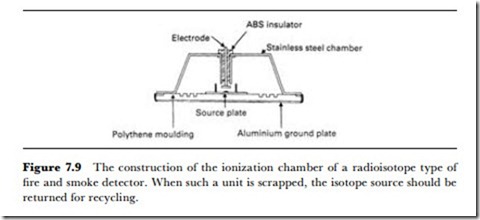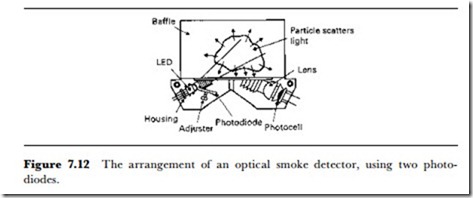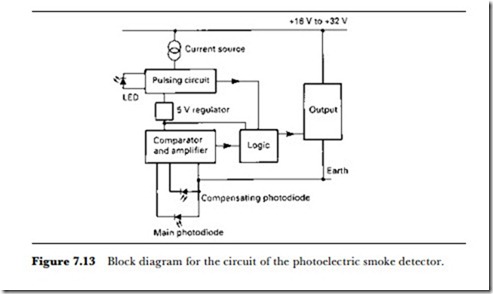Smoke and ire detectors
Smoke detectors for domestic use may become compulsory in the lifetime of this book, so that the methods used are now of considerable importance in domestic situations as well as industrially. In domestic premises, smoke detection is considered more important than the detection of fire by temperature change, because the asphyxiating effect of smoke from foam plastics is the prime cause of death in domestic fires. Industrial fires are more complex, and often involve very fast rates of temperature rise, sometimes with very little smoke.
Smoke detectors operate on two main principles: ionization detectors which will detect the ionized air from a fire even when there is little or no visible smoke, and the optical type, which is designed to detect smoke which is present even when there is little or no rise in temperature. In general, the ionization types are used industrially and the optical types in domestic uses.
The ionization type of detector uses a radioactive source, usually americium-241 (241Am95), with a low activity level, typically 0.8 jlCi. The arrangement of the ionization chamber is as shown in Figure 7.9. The gap between the source plate and the electrode is normally conducting due to the emission of alpha particles (helium ions) by the americium, which has a half-life of 458 years. The ion current is very small, of the order of 10 pA (1 pA = 10-12 A), so that any additional insulation leakage would be sub-
stantial in comparison. The acceptable level of insulation leakage is of the order of 0.5 pA. This implies that the insulators must not be touched, and if the ionization chamber has to be replaced, utmost care must be taken to avoid any contamination of the insulation by, for example, solder flux.
In the presence of smoke from a fire, particles entering the ionization chamber will be struck by the alpha particles, and the alpha particles will cling to the much larger particles of smoke. Because the charged units are now much larger, they cannot travel so quickly in air, and the current is reduced. By detecting the reduction in current, the detector can be made to activate an alarm. A typical circuit arrangement is illustrated in block form in Figure 7.10, using a MOSFET impedance converter (source- follower), comparator and output stage.
The optical type of detector operates on the well-known Tyndall effect of scatter (Figure 7.11). Vhen a beam of light passes through clean air, the
beam is invisible. No light can be detected looking along an axis at right angles to the beam. In the presence of smoke, however, light is scattered (randomly reflected) from the tiny particles that make up smoke, so that there is an appreciable amount of light visible on the transverse axis.
A typical optical scattering detector chamber is illustrated in Figure 7.12 with the size of a smoke particle shown in a magnified view. In the absence of smoke, the light-beam from the LED does not illuminate the photocell. There is a balancing photodiode provided so that any light reaching the photocell from internal reflection can be balanced out – this should be almost negligible because the interior of the detector is coated in matt black. In the presence of smoke, the scattered light from the smoke particles will cause an increase in the intensity of light reaching the main photocell with very little change at the compensating photodiode.
A typical circuit is illustrated in Figure 7.13, in block diagram form. The pulsing circuit for the LED is operated from a constant-current source
using a high peak current to provide a concentrated light beam. The inputs from the main photosensor and the auxiliary photodiode are compared, and the output of the comparator is used to drive the logic circuit which suppresses any output until three successive pulses of light all provide a smoke warning output. If this happens, the output is triggered, operating the alarm.
SERVICING
Both the ionization and the optical types of detector can be housed in similar casings that incorporate an insect screen and cover. Despite the covering, smoke detectors of both types are subject to a build-up of dust and cleaning is required at intervals. The insect screen must be cleaned using methylated spirit if any tarry or sticky deposits have formed. The cleaning procedures for the two types of detector then diverge.
The ionization chamber type of detector must have its central electrode removed, taking care not to damage the connecting lead. This exposes the low-level radioactive source, which must be treated with some care, because even though its intensity is lower than that of some granite rocks, you may be working with several units each day. You should therefore take the simple and sensible precautions that apply to any low-activity radioactive source, although the inhalation of fumes from methylated spirit is more of a hazard.
Radioactivity is dangerous only if you remain close to an intense source for some time, or swallow or breathe in particles of low-level material. The obvious steps are not to touch the radioactive source (which is sealed in any case) and not to place your fingers close to it. The recommendations are that you do not put your fingers closer than 50 mm (2in) from the source and do not place your eye closer than 150 mm (6 in) from the source. The unit can be cleaned using a brush dipped in methylated spirit, and drained (to avoid leaving drops). Use the same brush to clean the source, source plate, mounting and baffie to remove any traces of dirt.
Vhen the methylated spirit has evaporated, use another clean dry brush to remove any residues. Vhen cleaning of the unit is complete, clean the first brush in fresh methylated spirit and the drying brush in soap and water, and leave both to dry thoroughly before using again. The used methylated spirit should be kept in a clearly labelled bottle until the bottle becomes full, when it should be disposed of in the same way as any other solvent (there will be no measurable radiation from the methylated spirit). The detector components can then be reassembled.
The optical type of detector can be cleaned when the gauze and the baffie have been removed. A soft brush moistened with methylated spirit is used, taking care to brush the interior of the chamber to remove any traces of light-coloured dust which will cause excessive reflection. A dry dusting
brush should be used to remove dust from the LED and the photocells, lenses and housings. Brush the interior of the chamber only very lightly, because hard brushing can polish the surface, causing reflections. Following cleaning, the unit is reassembled.
TEMPERATURE TYPE
The fixed temperature type of fire detector is used extensively in industrial surroundings, and consists of a thermistor wired in a bridge circuit. The usual operating temperature is 57oC – a compromise between giving reason- ably early warning of a real fire and possible false alarms in very hot weather. The rate of rise system uses two thermistors in a bridge, with one thermistor embedded in a heat sink. Slow changes in the ambient temperature will affect both thermistors equally, so that no alarm is actuated even if there is a substantial change of temperature. In fire conditions, the thermistor that is in free air will heat much more rapidly than the thermistor in the heat sink, unbalancing the bridge and actuating the alarm. The rate of rise type is particularly effective in detecting fires in spaces which are normally held at a low temperature (such as cold rooms), since a normal temperature detector will not register until a fire is well advanced, because the initial temperature is so low.



